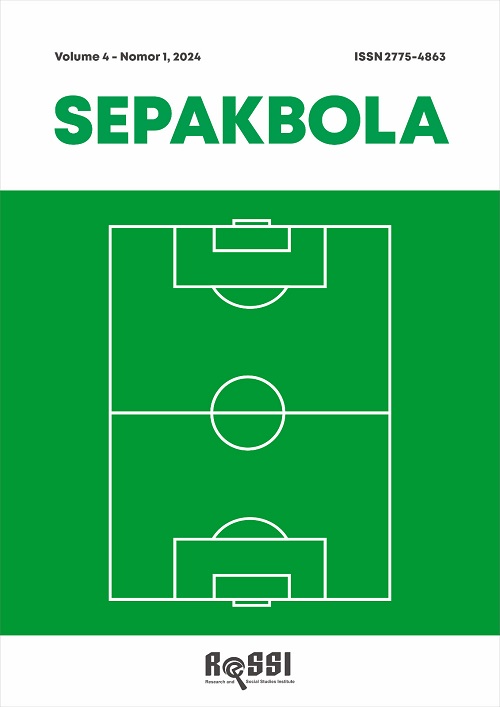Profil fisik pemain PSBI Blitar tahun 2022: Analisis komposisi tubuh
DOI:
https://doi.org/10.33292/sepakbola.v3i1.250Keywords:
Indeks Masa Tubuh, Presentasi Lemak, Pemain SepakbolaAbstract
Penelitian ini bertujuan untuk menganalisis komposisi tubuh pada pemain PSBI Kabupaten Blitar dengan memfokuskan pada faktor Indeks Massa Tubuh (IMT) dan persentase lemak tubuh. Sampel penelitian terdiri dari 26 pemain sepakbola yang merupakan anggota tim PSBI Kabupaten Blitar. Data komposisi tubuh dikumpulkan dan dianalisis untuk memberikan pemahaman yang lebih mendalam tentang kondisi fisik para pemain. Hasil penelitian mengungkapkan bahwa mayoritas pemain (92.3%) memiliki kategori IMT yang normal, sementara 2 pemain (7.7%) mengalami berat badan berlebih. Temuan ini menunjukkan variasi dalam komposisi tubuh antara para pemain. Penting untuk mempertimbangkan dampak berat badan berlebih terhadap kesehatan dan performa atlet. Berdasarkan analisis persentase . lemak tubuh, ditemukan variasi yang signifikan di antara pemain. Sebanyak 6 pemain (23.1%) memiliki persentase lemak tubuh cukup tinggi, sementara 1 pemain (3.8%) masuk dalam kategori persentase lemak tubuh tinggi. Sebanyak 19 pemain lainnya (73.1%) memiliki persentase lemak tubuh dalam kategori normal. Temuan ini menyoroti pentingnya mengelola persentase lemak tubuh pada pemain sepakbola, mengingat dampaknya terhadap performa fisik.
Â
Physical profile of PSBI Blitar players in 2022: Body composition analysis
Â
Abstract: This study aims to analyze the body composition of PSBI players in Blitar Regency by focusing on the factors of Body Mass Index (BMI) and body fat percentage. The research sample consisted of 26 soccer players who were members of the Blitar Regency PSBI team. Body composition data is collected and analyzed to provide a deeper understanding of the players' physical condition. The study's results revealed that most players (92.3%) had a normal BMI category, while two players (7.7%) were overweight. These findings suggest variations in body composition between the players. It is important to consider the impact that excess weight can have on the health and performance of athletes. Based on an analysis of body fat percentage, significant variations were found among players. Six players (23.1%) had a relatively high body fat percentage, while one player (3.8%) was in the high body fat percentage category. A total of 19 other players (73.1%) have a body fat percentage in the normal category. These findings highlight the importance of managing body fat percentage in soccer players, given its impact on physical performance.
References
Atakan, M. M., Unver, E., Demirci, N., Ci̇nemre, Ş. A., Bulut, S., & Turnagol, H. H. (2017). Effect of body composition on fitness performance in young male football players. Turkish Journal of Sport and Exercise, 19(1), Article 1.
Carling, C., Le Gall, F., Reilly, T., & Williams, A. M. (2008). Do anthropometric and fitness characteristics vary according to birth date distribution in elite youth academy soccer players?: Relative age effect in elite youth soccer. Scandinavian Journal of Medicine & Science in Sports, 19(1), 3–9. https://doi.org/10.1111/j.1600-0838.2008.00867.x
Carling, C., Reilly, T., & Williams, A. M. (2009). Performance assessment for field sports (1st edition). Routledge.
Da Silva, C. D., Bloomfield, J., & Marins, J. C. B. (2008). A review of stature, body mass and maximal oxygen uptake profiles of u17, u20 and first division players in brazilian soccer. Journal of Sports Science & Medicine, 7(3), 309–319.
Duthie, G., Pyne, D., & Hooper, S. (2003). Applied physiology and game analysis of Rugby Union. Sports Medicine, 33(13), 973–991. https://doi.org/10.2165/00007256-200333130-00003
Gil, S., Ruiz, F., Irazusta, A., Gil, J., & Irazusta, J. (2007). Selection of young soccer players in terms of anthropometric and physiological factors. The Journal of Sports Medicine and Physical Fitness, 47(1), 25–32.
Leão, C., Silva, A. F., Badicu, G., Clemente, F. M., Carvutto, R., Greco, G., Cataldi, S., & Fischetti, F. (2022). Body composition interactions with physical fitness: A cross-sectional study in youth soccer players. International Journal of Environmental Research and Public Health, 19(6), Article 6. https://doi.org/10.3390/ijerph19063598
Malina, R. M., Bouchard, C., & Bar-Or, O. (2004). Growth, maturation, and physical activity. Human Kinetics.
Norton, K., & Olds, T. (2006). Anthropometrica: A textbook of body measurement for sports and health courses. CBS Publishers & Distributors.
Reilly, T., Bangsbo, J., & Franks, A. (2000). Anthropometric and physiological predispositions for elite soccer. Journal of Sports Sciences, 18(9), 669–683. https://doi.org/10.1080/02640410050120050
Reilly, T., & Doran, D. (2003). Fitness assessment. In Science and Soccer (2nd ed.). Routledge.
Reilly, T., & Williams, A. M. (2003). Science and soccer (2nd ed.). Psychology Press.
Reilly, T., Williams, A. M., Nevill, A., & Franks, A. (2000). A multidisciplinary approach to talent identification in soccer. Journal of Sports Sciences, 18(9), 695–702. https://doi.org/10.1080/02640410050120078
Roemmich, J. N., & Sinning, W. E. (1997). Weight loss and wrestling training: Effects on growth-related hormones. Journal of Applied Physiology (Bethesda, Md.: 1985), 82(6), 1760–1764. https://doi.org/10.1152/jappl.1997.82.6.1760
Stølen, T., Chamari, K., Castagna, C., & Wisløff, U. (2005). Physiology of soccer: An update. Sports Medicine (Auckland, N.Z.), 35(6), 501–536. https://doi.org/10.2165/00007256-200535060-00004
Susilo, A. E. (2013). Hubungan persentase lemak tubuh terhadap daya tahan kardiorespirasi atlet pencak silat di klub SMP Negeri 01 Ngunut Tulungagung. Jurnal Kesehatan Olahraga. http://ejournal.unesa.ac.id/index.php/jurnal-kesehatan-olahraga/article/view/1844
Sutton, L., Scott, M., Wallace, J., & Reilly, T. (2009). Body composition of English Premier League soccer players: Influence of playing position, international status, and ethnicity. Journal of Sports Sciences, 27(10), 1019–1026. https://doi.org/10.1080/02640410903030305
Wittich, A., Oliveri, M. B., Rotemberg, E., & Mautalen, C. (2001). Body composition of professional football (soccer) players determined by dual X-Ray absorptiometry. Journal of Clinical Densitometry, 4(1), 51–55. https://doi.org/10.1385/JCD:4:1:51
Zahra, S., & Muhlisin, M. (2020). Nutrisi bagi atlet remaja. Jurnal Terapan Ilmu Keolahragaan, 5(1), 81–89. https://doi.org/10.17509/jtikor.v5i1.25097







